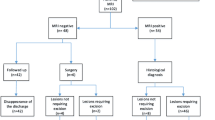Abstract
Background/aims
To investigate the diagnostic performance of breast MRI in revealing mammographically and sonographically occult lesions requiring excision in patients with pathologic nipple discharge.
Materials and methods
In this retrospective study, 57 women with pathologic nipple discharge who had normal or inconclusive mammography and ultrasonography results and underwent breast MRI were determined. Patients who had histopathological diagnosis or ≥ 1-year imaging follow-up were included. MRIs were classified as positive and negative according to final BI-RADS assessment categories. Diagnostic performance of MRI, including sensitivity, specificity, negative predictive value, and positive predictive value, was calculated for detecting both malignancy and lesions requiring surgery.
Results
Abnormal contrast enhancement on the pathologic nipple discharge side was detected in 29 MRIs (50.8%), categorized as BI-RADS 4. Abnormal findings were solid masses in 17 cases (58.6%) and non-mass enhancement in 12 cases (41.3%). Despite normal conventional imaging results, 4 malignant lesions and 16 lesions requiring surgery were detected with MRI. The sensitivity and specificity of MRI for detecting lesions requiring surgery were 100% and 68.2%, respectively. The positive predictive value (PPV) and negative predictive value were 55.1% and 100%, respectively.
Conclusion
In conclusion, this study confirmed that MRI is a reliable tool to detect lesions requiring surgery in patients with pathologic nipple discharge. MRI should be used in routine workup in patients with normal conventional imaging and imaging follow-up can be safely applied in patients with negative MRI.



Similar content being viewed by others
References
Seow JH, Metcalf C, Wylie E (2011) Nipple discharge in a screening programme: imaging findings with pathological correlation. J Med Imaging Radiat Oncol 55:577–586. https://doi.org/10.1111/j.1754-9485.2011.02294.x
Bahl M, Baker JA, Greenup RA et al (2015) Diagnostic value of ultrasound in female patients with nipple discharge. AJR Am J Roentgenol 205:203–208. https://doi.org/10.2214/AJR.14.13354
Morrogh M, Park A, Elkin EB et al (2010) Lessons learned from 416 cases of nipple discharge of the breast. Am J Surg 200:73–80. https://doi.org/10.1016/j.amjsurg.2009.06.021
Adepoju LJ, Chun J, El-Tamer M et al (2005) The value of clinical characteristics and breast-imaging studies in predicting a histopathologic diagnosis of cancer or high-risk lesion in patients with spontaneous nipple discharge. Am J Surg 190:644–646. https://doi.org/10.1016/j.amjsurg.2005.06.032
Vargas HI, Vargas MP, Eldrageely K et al (2006) Outcomes of clinical and surgical assessment of women with pathological nipple discharge. Am Surg 72:124–128
Ballesio L, Maggi C, Savelli S et al (2007) Adjunctive diagnostic value of ultrasonography evaluation in patients with suspected ductal breast disease. Radiol Med 112:354–365. https://doi.org/10.1007/s11547-007-0146-4
Das DK, Al-Ayadhy B, Ajrawi MT et al (2001) Cytodiagnosis of nipple discharge: a study of 602 samples from 484 cases. Diagn Cytopathol 25:25–37. https://doi.org/10.1002/dc.1098
Lippa N, Hurtevent-Labrot G, Ferron S et al (2015) Nipple discharge: the role of imaging. Diagn Interv Imaging 96:1017–1032. https://doi.org/10.1016/j.diii.2015.07.004
Berger N, Luparia A, Di Leo G et al (2017) Diagnostic performance of MRI versus galactography in women with pathologic nipple discharge: a systematic review and meta-analysis. AJR Am J Roentgenol 209:465–471. https://doi.org/10.2214/AJR.16.16682
Boisserie-Lacroix M, Doutriaux-Dumoulin I, Chopier J et al (2021) Diagnostic accuracy of breast MRI for patients with suspicious nipple discharge and negative mammography and ultrasound: a prospective study. Eur Radiol 31:7783–7791. https://doi.org/10.1007/s00330-021-07790-4
Fisher CS, Margenthaler JA (2011) A look into the ductoscope: its role in pathologic nipple discharge. Ann Surg Oncol 18:3187–3191. https://doi.org/10.1245/s10434-011-1962-2
Zacharioudakis K, Kontoulis T, Vella JX et al (2019) Can we see what is invisible? The role of MRI in the evaluation and management of patients with pathological nipple discharge. Breast Cancer Res Treat 178:115–120. https://doi.org/10.1007/s10549-019-05321-w
Waaijer L, van Diest PJ, Verkooijen HM et al (2015) Interventional ductoscopy in patients with pathological nipple discharge. Br J Surg 102:1639–1648. https://doi.org/10.1002/bjs.9950
Filipe MD, Waaijer L, van der Pol C et al (2020) Interventional ductoscopy as an alternative for major duct excision or microdochectomy in women suffering pathologic nipple discharge: a single-center experience. Clin Breast Cancer 20:e334–e343. https://doi.org/10.1016/j.clbc.2019.12.008
Filipe MD, Patuleia SIS, Vriens MR et al (2021) Meta-analysis and cost-effectiveness of ductoscopy, duct excision surgery and MRI for the diagnosis and treatment of patients with pathological nipple discharge. Breast Cancer Res Treat 186:285–293. https://doi.org/10.1007/s10549-021-06094-x
Bahl M, Baker JA, Greenup RA et al (2015) Evaluation of pathologic nipple discharge: what is the added diagnostic value of MRI? Ann Surg Oncol 22(Suppl 3):S435-441. https://doi.org/10.1245/s10434-015-4792-9
Lubina N, Schedelbeck U, Roth A et al (2015) 3.0 Tesla breast magnetic resonance imaging in patients with nipple discharge when mammography and ultrasound fail. Eur Radiol 25:1285–1293. https://doi.org/10.1007/s00330-014-3521-2
Ballesio L, Maggi C, Savelli S et al (2008) Role of breast magnetic resonance imaging (MRI) in patients with unilateral nipple discharge: preliminary study. Radiol Med 113:249–264. https://doi.org/10.1007/s11547-008-0245-x
Author information
Authors and Affiliations
Corresponding author
Ethics declarations
Ethics approval
This retrospective study was approved by the institutional review board, and the requirement of written informed consent was waived.
Conflict of interest
The authors declare no competing interests.
Additional information
Publisher's Note
Springer Nature remains neutral with regard to jurisdictional claims in published maps and institutional affiliations.
Rights and permissions
Springer Nature or its licensor (e.g. a society or other partner) holds exclusive rights to this article under a publishing agreement with the author(s) or other rightsholder(s); author self-archiving of the accepted manuscript version of this article is solely governed by the terms of such publishing agreement and applicable law.
About this article
Cite this article
Avdan Aslan, A., Gültekin, S. What is the role of breast MRI in the management of women with pathologic nipple discharge and normal conventional imaging?. Ir J Med Sci 192, 2331–2335 (2023). https://doi.org/10.1007/s11845-022-03230-4
Received:
Accepted:
Published:
Issue Date:
DOI: https://doi.org/10.1007/s11845-022-03230-4




